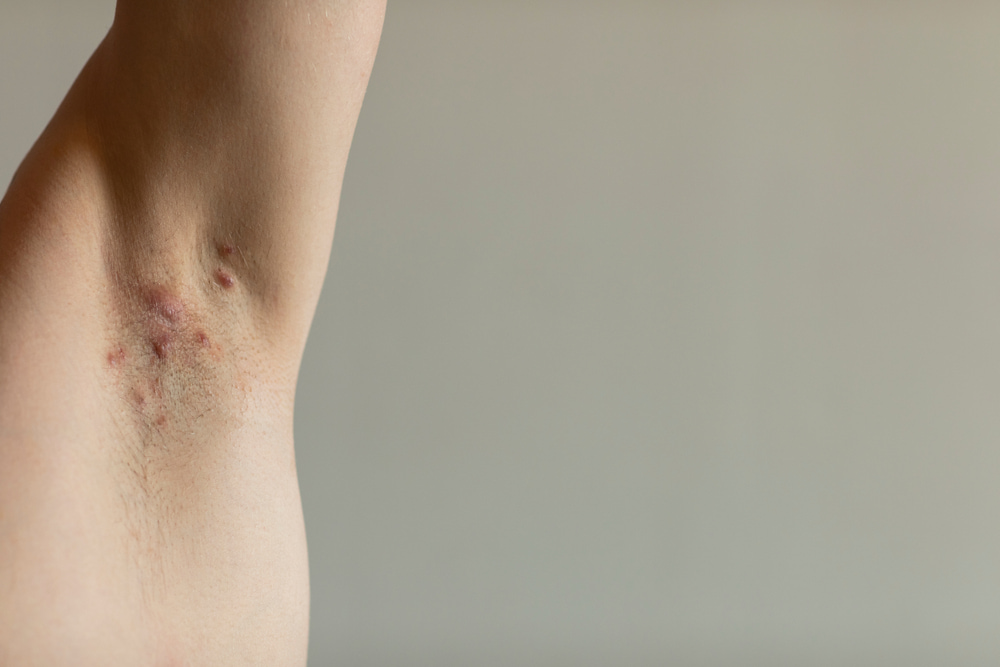Introduction
Hidradenitis Suppurativa (HS) is a chronic skin condition that causes painful bumps and abscesses in areas such as the armpits, groin, and under the breasts. This condition can be both physically and emotionally challenging, significantly impacting daily life and mental health. While there is no definitive cure for HS, various treatments can help manage symptoms and improve the quality of life for those affected. One promising treatment option is laser hair removal, which has the potential to alleviate symptoms and reduce flare-ups.
What is Hidradenitis Suppurativa?
HS is a long-term skin condition characterized by inflamed, painful lumps under the skin. These lumps can break open and lead to tunnels under the skin, which can be particularly distressing and lead to scarring. The exact cause of HS is not fully understood, but it is believed to be linked to hair follicles becoming blocked and inflamed. Factors such as genetics, hormonal changes, and lifestyle choices can contribute to the development and progression of HS.

The symptoms of HS typically start after puberty and can worsen over time if not managed effectively. These symptoms include painful bumps, abscesses, and sinus tracts that can drain foul-smelling fluid. The condition often has a significant impact on daily activities, self-esteem, and mental health, as individuals may feel self-conscious about their appearance and experience chronic pain.
Why Hair Removal?
Hair follicles play a crucial role in the development and progression of HS. When hair follicles become blocked, they can become inflamed and lead to the formation of painful lumps and abscesses. Reducing hair growth in areas prone to HS can potentially decrease the severity and frequency of flare-ups. This is where laser hair removal comes into play.
Laser Hair Removal Explained
Laser hair removal is a medical procedure that uses concentrated light to target and eliminate hair follicles. During the procedure, a laser emits a specific wavelength of light that is absorbed by the pigment in the hair. This light energy is converted to heat, which damages the hair follicle and inhibits future hair growth.
Different types of lasers can be used for hair removal, including the Alexandrite, Diode, and Nd lasers. Each type has its advantages and can be chosen based on the patient's skin type and hair color. For HS patients, laser hair removal can help reduce hair in areas prone to flare-ups, leading to fewer blockages and less inflammation.
Benefits of Laser Hair Removal for HS
Laser hair removal offers several benefits for individuals with HS, making it a valuable part of their management plan:
- Reduced Skin Irritation: By removing hair, laser treatment can decrease friction and irritation in affected areas, leading to fewer flare-ups.
- Fewer Abscesses: With fewer hair follicles to become blocked, the likelihood of developing painful abscesses is reduced.
- Decreased New Lesion Development: Consistent laser hair removal can prevent new lesions from forming, helping to manage the progression of HS.
- Improved Quality of Life: Patients often experience less pain and discomfort, leading to improved overall well-being.
Additionally, treatments such as CO2 Laser Resurfacing, Fraxel, and Pico Laser Facial may be relevant for specific patient needs. These treatments can help address scarring and improve skin texture, complementing the benefits of laser hair removal.
Treatment Expectations and Experience
Understanding what to expect during and after laser hair removal sessions is crucial for patients considering this treatment. Typically, multiple sessions are required to achieve optimal results, with sessions spaced several weeks apart. During the treatment, patients may experience a mild stinging sensation, similar to a rubber band snapping against the skin. Topical anesthetics can be used to minimize discomfort.
After the procedure, it is common to experience some redness and swelling in the treated area, which usually subsides within a few hours to a couple of days. Proper post-treatment care, such as avoiding sun exposure and using soothing creams, can help manage any temporary side effects.
Choosing the Right Specialist
Selecting a qualified dermatologist or laser specialist is essential for safe and effective laser hair removal. Look for providers with experience in treating HS and ensure they have the necessary certifications and positive reviews. Beacon Dermatology, for example, offers specialized care for HS patients, ensuring they receive the best possible treatment.
FAQs
Can laser hair removal completely cure Hidradenitis Suppurativa?
Laser hair removal cannot cure HS, but it can significantly reduce symptoms and improve quality of life by preventing hair follicles from becoming inflamed.
How many laser sessions are typically needed for HS patients?
The number of sessions varies depending on the individual's condition and hair growth patterns. Most patients require multiple sessions, usually between 6 to 8, to achieve the best results.
What are the risks of laser hair removal for someone with HS?
While laser hair removal is generally safe, potential risks include temporary redness, swelling, and changes in skin pigmentation. It is essential to choose a qualified specialist to minimize these risks.
Does insurance cover laser hair removal?
Coverage for laser hair removal varies by insurance provider and plan. It is advisable to check with your insurance company to determine if this treatment is covered under your policy.
Conclusion
Laser hair removal offers a promising option for managing Hidradenitis Suppurativa, providing relief from painful symptoms and improving the quality of life. By reducing hair growth in affected areas, this treatment can help prevent flare-ups and reduce the severity of HS. If you are considering laser hair removal, consult with the specialists at Beacon Dermatology to discuss your specific needs and start your treatment journey toward effective HS management.